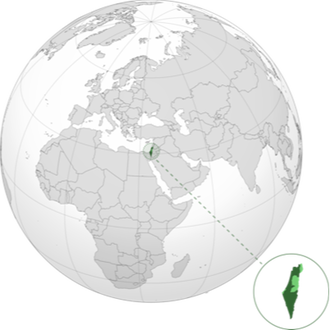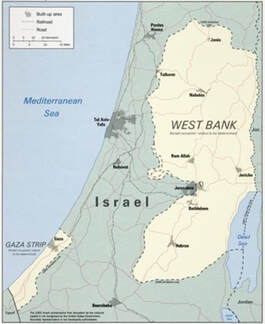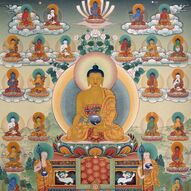|
Unity Antiracism Literacy Partners Ask: What? When? Where in the World? Shelley Butler, Beloved Community Communications and Antiracism Literacy Partners (ALP) Teams With a swift end to the conflict in Israel and Gaza nowhere in sight (not to mention other violence around the world and in our own neighborhood), if you’re like me, then you’re having trouble saying, “Happy New Year,” to friends and family. I found myself wishing people a “more peaceful” or “happier” new year and receiving similar sentiments. Since October 7, 2023, I have been reading, watching, listening, debating, and learning about Israel, Hamas, Palestine, and the 17.37 sq. mile Gaza Strip, as I suspect have most of us. The question that often calls us to action looms: What can I do? An article by Rabbi Emily Cohen stood out to me, and her words have become my mantra, “I will not lose my compassion for all: Israeli and Palestinian, Arab and Jew. I have found myself for these last weeks living in the ‘and,’ and I want to invite you to live there with me.” We, on the Antiracism Literacy Partners (ALP) Team, invite you to live in the “and” with fellow Unity congregants by delving into questions more deeply in small group spiritual practice. So, what does that mean exactly? Join us on Tuesday, January 9, 2024, at 7:00pm on Zoom (register here) to find out more about the new resource being offered, “We Cannot Turn Away: Engaging on Israel and Palestine.” Then, you will be able to sign up for a small group to discuss these four questions:
You’ve likely watched unspeakable violence unfold; heard phrases like “from the river to the sea” and “settler colonialism”; wondered about the difference between Jews and Zionists, and the difference between Hamas, Hezbollah, and the Palestinian Authority; been informed about antisemitic and Islamophobic harassment and violence; been surprised to find trusted leaders, groups, and organizations siding with Israelis or Palestinians; and felt perplexed by sorting out right from wrong when both sides are engaged in war crimes. News outlets and especially social media abound in information and misinformation, understanding and misunderstanding. There is much to sort out. The ALP program can’t promise to answer all the questions, but we do offer a starting point. Unlike most other ALP groups, we’ll offer you a resource guide with articles, news stories, UUA statements, links to short films and podcasts, and as always, recommendations to learn more, instead of a single book or podcast. Rather than choosing sides, we encourage you to enter with an open heart and mind into the complexity of the 3000-year history of the area; how our faith is responding; and thoughts on where we might go from here, including building bridges in time of war. Several of the resources provided, as well as a guide to “key terms,” have been provided by the UUA for just this purpose of congregations engaging on Israel and Palestine. As we start this new year that seems so filled with uncertainty, I’d like to offer you the blessing given me by a fellow BC Communications Team member, “May the New Year bring you and all of us new challenges and a good measure of joy.” The Antiracism Literacy Partners (ALP) program is a group spiritual practice that seeks to embody the values, mission, and ends of Unity Church; and specifically, this ends statement: Create brave space for racial healing and dismantling dominant culture. Learn more about the Antiracism Literacy Partners program, and the five resources offered in the January session. Contact ALP Team Leader Becky Gonzalez-Campoy with questions: beckygc83@gmail.com.
0 Comments
Paul Rogne, Guest Writer from Unity's Art Team  In November 2023, the Unity Church Art Team featured a Parish Hall exhibit of artwork by Rose and Melvin Smith, esteemed elders in the African American artist community of the Twin Cities. It was the culmination of a journey that began in 2021 when the art team sought these artists out hoping to purchase one of their paintings. After visiting with the art team and touring Unity to see the permanent art collection, Rose and Melvin agreed to sell one of Rose’s fine paintings, an image of a woman she met in New Orleans following Hurricane Katrina. That painting now hangs in the Center Room. The Smiths told us they were impressed with Unity and wanted to thank our church community for its commitment to promoting the arts. Their interest and ours resulted in an exhibition of their most recent work, none of which had ever been shown. Over the years, the artist couple has exhibited several times in New York City; their works depicting scenes and impressions of life in the history of the Rondo neighborhood are currently being featured in a Manhattan gallery. They have also exhibited in Chicago, Oklahoma, and at the Weisman Museum in Minneapolis. It has been a privilege to have them exhibit new work at Unity Church. Rose’s latest is a series of canvases capturing flowers arranged in the style of the Japanese art form, Ikebana. Melvin’s colorful collages were inspired by the classical American dance form the Jitterbug. Why did the art team reach out to these particular artists? In addition to the quality of the work, the team looks to questions prompted by Unity’s Ends Statements (2018) in considering the criteria to use in selecting artists for this program:
If our ends statements plus Unity’s mission to “transformation through a free and inclusive religious community …” are to be taken seriously, then the art team is determined to move forward on them. What shows that movement up to this point? Not only have we shown and continue to invite artists of greater diversity regarding ethnicity, race, gender, culture, religion, sexual identity, socioeconomic, physical ability, and neurodiversity to participate in Unity’s monthly exhibitions but we have also expanded the church’s permanent art collection featured throughout the building to include this diversity. There are now many more artists from our greater community represented on our walls including artists of color, LGBTQ+, Hmong, Karen, and more. In 2022, Mica Lee Anders, a Rondo neighbor and accomplished artist and educator, led a group of Unity volunteers to create an eye-catching new Foote Room mural. The shape of the overall design is familiar to Unitarian Universalists — a chalice. In October 2023, the Parish Hall featured works created by artists incarcerated in Minnesota correctional facilities. These talented artists claim roots in a variety of ethnicities and cultures. Art From the Inside, the organization that brought them here, was able to hold a successful fundraiser at Unity, and was the recipient of a Sunday offering —another example of how the art team strives to act on our ends. We know there is much more to do, but it is exciting and rewarding work. The art team urges everyone at Unity Church to be curious. Take a moment to look at the artwork as you wander through the hallways or gather for a meeting. Chances are you are seeing art that represents the concerns, ideas, thoughts, and/or feelings of a member of our greater Beloved Community. That should be reason enough to take notice. By Rebecca Gonzalez-Campoy and Rev. KP Hong, Beloved Community Communications Team In his book, Faith Without Certainty: Liberal Theology in the 21st Century, UU theologian Paul Rasor lays out plainly how liberal religion is fraught with challenges to examining spirituality and putting it to work to address racism. He writes:
Unity recently concluded a three-part workshop, “Spiritual Practice: Discovery and Transformation,” that brought participants together in conversation and exploration of how to do what Rasor describes: develop spiritual practices that engage in antiracism work. To be effective, one cannot exist without the other, says Rev. KP Hong, Minister of Faith Formation and one of the workshop leaders. Anything less continues to support white supremacy. This was precisely the question Martin Luther King, Jr., brought into prophetic focus, wondering how spiritual practice on Sunday morning could be emblematic of “one of the most segregated hours” in America, a racialized spiritual practice in collusion with white supremacy. And equally significant, King relentlessly interrogated what racial justice requires and, with other members of the civil-rights generation, formulated nonviolence as the “only weapon that could cut and heal at the same time,” an antiracist practice necessarily grounded in disciplined spiritual practice. Unity provides many opportunities to engage in antiracist multicultural action. This workshop sought to look at the faith formation side of things, and raised many questions as participants considered how to create or enhance their own practices. One example: “How do I know I’m not living out my value of perfection?” Workshop leaders offered this advice: Is your practice me-centered or other-centered? Does it make you just feel good or do you push yourself to go beyond your comfort zone, to push boundaries? To disrupt? Perfectionism is me-centered. When one pursues excellence, it can be we-centered if benefiting others is your goal. Spiritual practice can take many forms. Body awareness work, zazen meditation, prayer, writing, art, walking or working in the natural world, chalice circles, worship, Lectio Divina, and music are among many possibilities. The key here is the word “practice.” Whatever you choose, commit to doing it each day, with intention and discipline. The first session established an understanding of spiritual practice as our way of being with the (w)holy, with what is greater than me and the countless boundaries that we erect to establish, fortify, and protect our preferred sense of self. At its core, then, spiritual practice summons us to the borders of our being, knowing, and ways of moving through the world – whether the borders of my personal identity or my tribe or the checkpoints along the Rio Grande. What happens at the border with the Other and the Not-Me? As King reflected on the Parable of the Good Samaritan, “the first question that the Levite asked was, ‘If I stop to help this man, what will happen to me?’ But then the Good Samaritan came by, and he reversed the question: ‘If I do not stop to help this man, what will happen to him?’” The second session explored what those practices might look like, stepping beyond the border of theory into practice, beyond the border of understanding into experiencing. The third and final gathering brought together spiritual practice and antiracist practice as an inescapable mutuality, a “double helix” in which the parallel helices of spiritual practice and antiracist practice co-create, authenticate, and prophetically keep each other from being co-opted and appropriated by white supremacy encoded throughout our history, culture, and structures. Participants will be invited to a follow-up session in February to review their progress. However, you may attend in February even if you did not take part in the fall series. To find out even more about spiritual practice, check out the Spiritual Practice page on the Unity Website to get some ideas. Of particular interest are the Spiritual Practice Packets organized around our monthly themes. You do not need to be in a chalice circle to use the packet. Find copies in the kiosk in the main lobby and on the Spiritual Practice bulletin board just outside the kitchen. The packet this month centers on the worship theme for October, “confessing.”
|
Topics
All
Beloved Community ResourcesUnity Justice Database
Team Dynamics House of Intersectionality Anti-Racism Resources in the Unity Libraries Collection Creative Writers of Color in Unity Libraries The History of Race Relations and Unity Church, 1850-2005 Archives
March 2024
Beloved Community Staff TeamThe Beloved Community Staff Team (BCST) strengthens and coordinates Unity’s antiracism and multicultural work, and provides opportunities for congregants and the church to grow into greater intercultural competency. We help the congregation ground itself in the understanding of antiracism and multiculturalism as a core part of faith formation. We support Unity’s efforts to expand our collective capacity to imagine and build the Beloved Community. Here, we share the stories of this journey — the struggles, the questions, and the collaborations — both at Unity and in the wider world.
The current members of the Beloved Community Staff Team include Rev. Kathleen Rolenz, Rev. KP Hong, Rev. Lara Cowtan, Drew Danielson, Laura Park, Lia Rivamonte and Angela Wilcox. |



